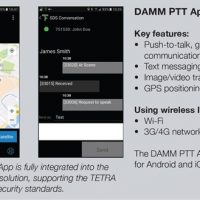

We review the new compliance policy settings and select Create. Here, we add the dynamic group we created "A_SM_XCover_MU" and click Select.Īssigning a new group to include and assign to the new fully managed, dedicated, and corporate-owned work profile compliance policy. We leave the default settings on the Actions for noncompliance tab and continue to Assignments. We choose the minimum OS version as the compliance setting and set the value to "10".Ĭonfiguring the minimum OS version as the compliance setting with a value of "10".

Facebar app ptt android#
We name our example "A_SM_XCover_MU_Compliance".Ĭreating a new Android Enterprise fully managed, dedicated, and corporate-owned work profile compliance policy in the Microsoft Endpoint Manager admin center. The next step is to define a name and optionally a description in the Basics section. This setting might have been changed in your environment, but we create and assign a custom compliance setting for our shared devices for our testing.įirst, we create a new compliance policy and select Android Enterprise as the platform and Fully managed, dedicated and corporate-owned work profile as the profile type.Ĭreating a new policy Android Enterprise Fully managed, dedicated and corporate-owned work profile compliance policy in the Microsoft Endpoint Manager admin center. The default settings of Intune require a custom compliance policy. Now, all devices that are enrolled with this profile in Intune automatically become members of our group.Ĭreate a compliance policy for shared devices Under Property, we select enrollmentProfileName, then under Operator, select Equals, and under value, we enter the profile name " A_SM_XCover_MU."ĭynamic membership rules, properties and value examples highlighted in the Microsoft Endpoint Manager admin center. We define the rule criteria under Dynamic device members > Add a dynamic query. When you create this new group, make sure to select Dynamic Device in the Membership type field.Ĭreating a new Azure Active Directory (Azure AD) dynamic device group in the Microsoft Endpoint Manager admin center.Īs a membership criterion for the group, we use the name of the enrollment profile. We use the same enrollment profile name that we used for our device group: "A_SM_XCover_MU". We will use this dynamic group to assign policies, apps, and configurations, including the PTT configuration, to each new device that belongs to that group. Next, we create a new device group to dynamically add all Samsung models with the same enrollment profile. The example enrollment profile looks like this:Įnrollment token example for a Corporate-owned dedicated device with Azure AD shared device mode in the Microsoft Endpoint Manager admin center.
Facebar app ptt for android#
For detailed instructions, see Setup Intune enrollment for Android Enterprise dedicated devices and Shared device mode for Android devices.įor this example, in the Microsoft Endpoint Manager admin center we created a new enrollment profile named “A_SM_XCover_MU” with the token type Corporate-owned dedicated device with Azure AD shared mode.Ĭreating a new corporate-owned dedicated device profile in the Microsoft Endpoint Manager admin center. This is required to enable devices to support multiple users.
Facebar app ptt pro#
In this post, we will walk through the steps to configure the Microsoft Teams PTT functionality for Intune-managed Samsung XCover Pro devices in Microsoft Endpoint Manager.įirst, we need to and set up a device group for Samsung devices that are corporate-owned dedicated devices with Azure Active Directory (Azure AD) shared device mode.
Facebar app ptt how to#
For more info on this feature and applicable scenarios, see How to use Microsoft Teams Walkie Talkie on your Galaxy XCover Pro | (). Once configured and connected to a channel, you can use PTT functionality with the click of a button. Samsung offers the ability to configure a hardware button for the Walkie Talkie app on the Galaxy XCover Pro.

The app provides instant push-to-talk (PTT) communication from a mobile device, without having to start Microsoft Teams or dial a phone number.

However, for specific scenarios that require fast and direct communication, you can use the Walkie Talkie app in Microsoft Teams. With the digital transformation of the last decade, workers need devices that offer more functionality and line-of-business applications, such as inventory management systems or Microsoft Teams for collaboration and communication. For a long time, frontline workers used walkie-talkies (two-way radios) as the primary tool to communicate with colleagues and supervisors during their shifts. By Lothar Zeitler – Senior Program Manager | Microsoft Endpoint Manager – Intuneįrontline workers are essential in global workforces, performing critical jobs as first responders, supply chain workers, and many other roles across industries.


 0 kommentar(er)
0 kommentar(er)
